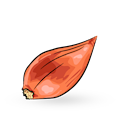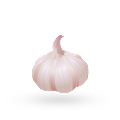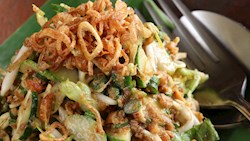MAIN INGREDIENTS
Pepes tahu is a traditional dish hailing from West Java. It consists of spiced and steamed tofu that’s cooked in banana leaves. The ingredients usually include tofu, banana leaves, bell peppers, green onions, and a spice paste consisting of shallots, garlic, sugar, salt, and hot chili peppers.
The tofu is drained and mashed, then combined with the spice paste, bell peppers, and green onions. The combination is wrapped in banana leaves, steamed, then served while still warm with rice on the side. Alternatively, pepes tahu can be grilled instead of steamed, if desired.
Kupat tahu is a traditional dish consisting of ketupat (a type of rice cake) and tofu in peanut sauce. The ingredients usually include rice cakes, tofu, bean sprouts, chili peppers, peanuts, garlic, brown sugar, water, and kecap manis soy sauce.
The tofu is fried until golden brown, the bean sprouts are blanched, and the peanuts are fried, then combined with garlic, chili peppers, and water in order to create the peanut sauce, which is additionally mixed with brown sugar. The rice cakes, fried tofu, and bean sprouts are topped with the peanut sauce, and the dish is then drizzled with sweet soy sauce.
If desired, kupat tahu can be enriched with lime juice and garnished with shrimp crackers. This dish is traditionally served for breakfast.
MAIN INGREDIENTS
Wajik or wajid is a traditional sticky rice cake originating from Java. It's usually made with a combination of glutinous rice, palm sugar, coconut milk, pandan leaves, and salt. The glutinous rice is soaked, washed, steamed, and cooked in a skillet with coconut milk until it's absorbed.
Pandan leaves are cooked with palm sugar until caramelized, and coconut milk and salt are then added to the mixture. Once the mixture is boiling, sticky rice is stirred in, and wajik is poured into a baking pan. After a few minutes, it's cut into diamond shapes and served.
MAIN INGREDIENTS
Buntil is a traditional dish hailing from Java, consisting of grated coconut, red peppers, chili, onions, garlic, anchovies, salt, and sugar wrapped in taro, cassava, or papaya leaves. The combination is boiled in coconut milk and spices such as garlic, turmeric, lemongrass, and lemon leaves.
Buntil is often prepared at home, but it can also be found in local restaurants or street side stalls called warungs. The dish is especially popular during Ramadhan.
Rujak petis is a traditional salad and a specialty of Ponorogo, East Java. This type of rujak is similar to rujak cingur, but it's meatless. The dish usually contains sliced mango, cucumbers, water spinach, jicama, kedondong (June plums), soybean sprouts, and tofu.
The ingredients are served in a dark sauce made from black fermented prawn paste called petis (hence the name of the dish), palm sugar, shallots, salt, and ground or crushed peanuts. Although this salad was traditionally served on banana leaf plates in the past, nowadays it's served on standard plates, and it's often topped with fried shallots.
Oncom is a traditional product that is fermented with mold. The base of every oncom is prepared with various by-products such as soy pulp, peanut and coconut press cake, or cassava tailings that are fermented with two types of mold to create red and black oncom varieties.
Often praised for its low cost and high nutritional value, oncom can be enjoyed as a stand-alone snack or wrapped in banana leaves. It is mainly produced and consumed in West Java.
MAIN INGREDIENTS
Lalap or lalab is a traditional salad originating from West Java. Although there is no set recipe for the salad, it's often made with raw vegetables such as tomatoes, lemon basil, green eggplants, cucumbers, cabbage, and long beans, along with blanched or boiled chayote, spinach, papaya leaves, water spinach, and cassava leaves.
The salad is served cold or at room temperature, and it's always accompanied by sambal terasi dipping sauce. Lalap can also be served as a side dish with pepes, fried fish, and fried chicken.
Tahu campur is a traditional dish originating from East Java. Although there is a number of variations on it, this soup is usually prepared with a combination of beef broth, fried tofu, green salad, bean sprouts, egg noodles, sambal petis (bird’s eye chili peppers and dried shrimp paste), spiced fried cassava (lentho), garlic crackers (krupuk bawang), and a spice paste containing garlic, coriander, cumin, turmeric, and black pepper.
When served, the broth is usually garnished with fried garlic, fried shallots, and krupuk bawang garlic crackers. This dish is often prepared and sold by street cart vendors in East Java.
MAIN INGREDIENTS
This traditional coconut cake is typically associated with Java, more precisely the region of Lamongan and the small city of Babat. Though the ingredients may vary, it is usually prepared with rice flour, grated coconut, and fresh coconut milk.
It is typically round in shape, though it can differ in size. Wingko is usually sold by street vendors, peddlers, or on trains, but it can also be found at specialized shops.
MAIN INGREDIENTS
Nasi kucing is a traditional dish originating from Surakarta, Yogyakarta, and Semarang in Central Java. The dish consists of a small portion of rice that's topped with ingredients such as tempeh, dried fish, and sambal, or in some cases cucumber, chicken, and eggs.
The combination traditionally comes wrapped in banana leaves. The name of the dish means cat's rice, referring to the small quantity of rice that's usually served as a part of the dish. Nasi kucing can be found at small roadside eateries or food stalls.
TasteAtlas food rankings are based on the ratings of the TasteAtlas audience, with a series of mechanisms that recognize real users and that ignore bot, nationalist or local patriotic ratings, and give additional value to the ratings of users that the system recognizes as knowledgeable. For the “36 Worst Rated Javanese Foods” list until March 27, 2025, 3,008 ratings were recorded, of which 1,972 were recognized by the system as legitimate. TasteAtlas Rankings should not be seen as the final global conclusion about food. Their purpose is to promote excellent local foods, instill pride in traditional dishes, and arouse curiosity about dishes you haven’t tried.





































